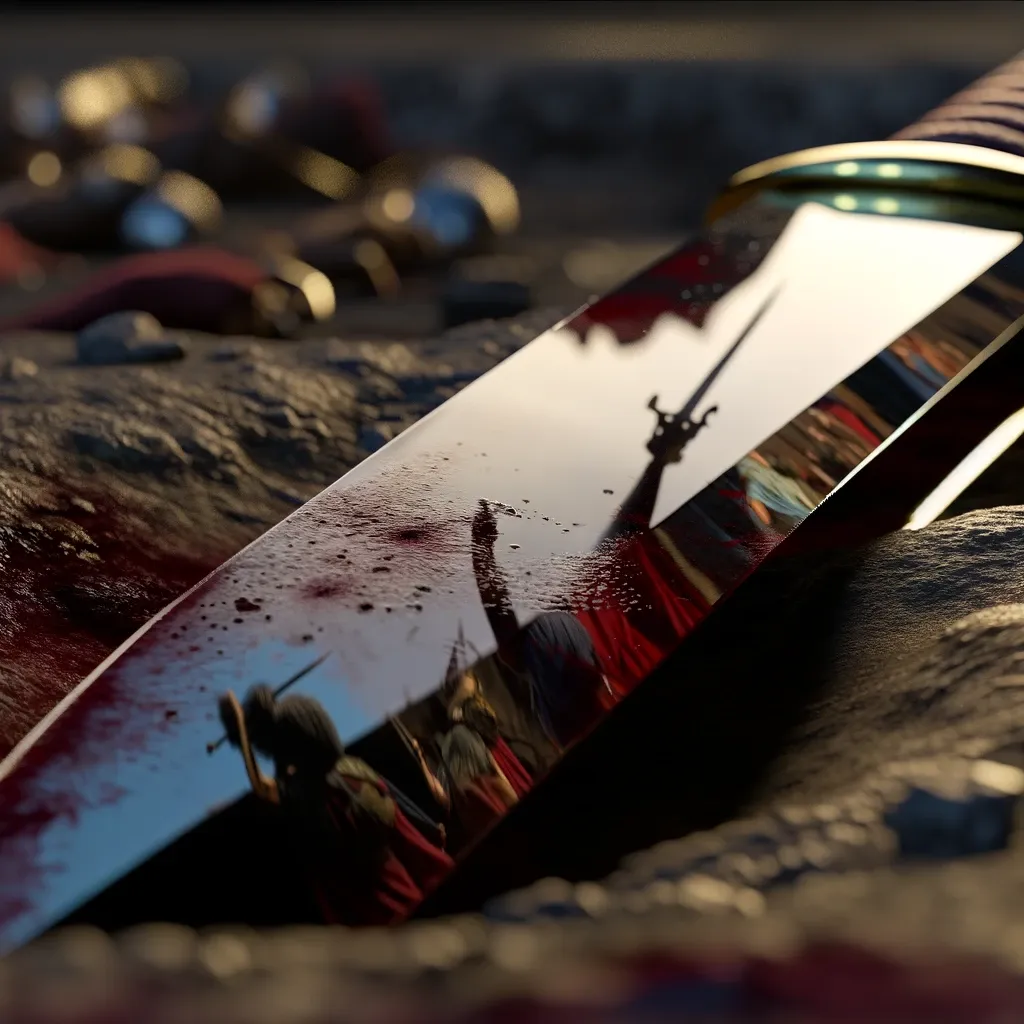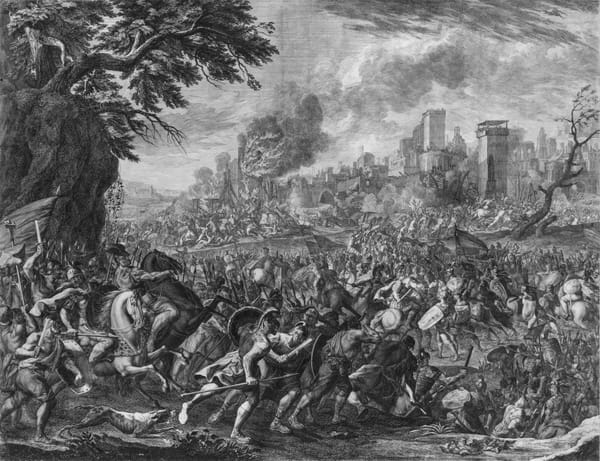Who was the best Roman warrior? Scipio Africanus: A man who never lost a battle.
Scipio Africanus: The greatest warrior of the Roman Empire.

In Roman Empire’s history, few figures stand as prominently as Scipio Africanus, the brilliant Roman general who played a pivotal role in shaping the destiny of the ancient world.
Early Life and Rise to Prominence
Scipio Africanus, originally named Publius Cornelius Scipio, entered the world around 236 BCE into the esteemed gens Cornelia, a venerable lineage within Roman society. Details of his upbringing are scarce, but being born into the Roman aristocracy, it is likely that he received an education befitting a future statesman of the Republic, including early immersion in military training. This rigorous preparation laid the groundwork for Scipio's eventual rise as one of Rome's most illustrious generals.
Scipio's journey into military prominence began at a remarkably young age, as he found himself thrust into the tumultuous arena of the Second Punic War at just 17 years old in 218 BCE. The conflict erupted with the Carthaginian commander Hannibal Barca's audacious crossing of the Alps into Italy, a feat previously deemed impossible. Hannibal's subsequent victory over Roman forces at the Battle of Ticinus sent shockwaves through Rome.
In the midst of this chaos, Scipio's father, Consul Publius Cornelius, found himself besieged by enemy forces. It was in this dire moment that young Scipio first displayed his valor, rallying the troops and leading a daring charge against superior numbers to rescue his father from imminent danger. His courageous actions earned him the prestigious Corona Civica, an oak wreath awarded for saving the life of a fellow citizen. However, true to his character, Scipio humbly declined this honor, exemplifying the blend of bravery and humility that would define his illustrious career.
The Battle of Ticinus marked the beginning of a series of devastating setbacks for the Romans as Hannibal advanced through Italy. Despite Roman discipline and logistical prowess, they found themselves outmatched by Hannibal's unparalleled tactical brilliance.
Hannibal's utilization of stratagems, ambushes, and traps proved devastating, leading to the demise of legion after legion over three grueling years of conflict. The culmination of this relentless onslaught came in 216 BCE at the Battle of Cannae, where approximately 50,000 Roman soldiers met their demise in a single day of ferocious combat. Among the casualties, one Roman commander perished, while another fled the battlefield in defeat. According to Livy, Scipio emerged as one of the few high-ranking officers to survive the massacre. Demonstrating remarkable leadership, Scipio organized the largest contingent of survivors and guided them to safety amidst the chaos.

The Battle of Cannae stood as a harrowing defeat for the Romans, but for Scipio, it served as a crucible for learning about Hannibal's tactics and strategies. With a keen eye for adaptation, Scipio absorbed valuable insights from the battlefield, which he would later utilize to defend Rome and secure its survival.
The Conquest of Spain: A Test of Leadership
In the same year as the catastrophic defeat at Cannae, Publius Cornelius, Scipio's father, returned to Spain with a conviction that traditional strategies would not suffice to overcome Hannibal. He believed that the Roman military needed to target the Carthaginian power base in Spain, which he considered to be their most vulnerable point.
Tragically, in 211 BCE, Publius Cornelius met his demise in battle, leaving Rome in a state of disarray. With Hannibal still a looming threat in Southern Italy and the bulk of his Carthaginian forces maintaining control in Spain, Rome thirsted for vengeance. However, the loss of many aristocrats dampened enthusiasm for assuming command. It was in this tumultuous period that young Scipio stepped forward. Despite his tender age of 26, an unprecedented youth for such a significant role, he volunteered to lead the Roman forces. The Senate granted him the position of proconsul, second only to the consul in military authority.
Arriving in Spain with only modest reinforcements, Scipio faced the daunting challenge of confronting three Carthaginian armies led by Hannibal's brother, Hasdrubal. Each of these armies outnumbered his own forces. Rather than adopting a defensive stance, Scipio opted for a bold offensive strategy, targeting the heart of the enemy's power.
Carthago Nova, present-day Cartagena, stood as the most formidable Carthaginian stronghold in Spain, surrounded by a natural lagoon that rendered it seemingly impregnable. However, Scipio, ever resourceful, gleaned valuable intelligence from local fishermen. Learning that the lagoon could be traversed at low tide, he devised a daring plan. Under the cover of darkness, Scipio and his troops waded through the shallow waters, launching a surprise assault on the city and seizing it from within.
Scipio allowed his soldiers to take everything they wanted from the city, but did not allow them to touch the citizens.
Over the ensuing four years, Roman and Carthaginian forces clashed in Spain in a series of engagements, with Scipio implementing tactics he had gleaned from observing Hannibal. In 208 BCE, during the Battle of Baecula, Scipio executed his renowned pincer maneuver for the first time.
Confronted with a numerically superior enemy, Scipio strategically divided his main forces into two potent wings, which swiftly enveloped the Carthaginian flanks. Despite the tactical success, the elusive Carthaginian commander managed to evade capture. Subsequently, defeated, Hasdrubal and his remaining troops retreated across the Pyrenees with intentions to join forces with his brother Hannibal. However, their plans were thwarted when they encountered another Roman army in Italy, resulting in their ultimate destruction and Hasdrubal's demise in battle.
With the scales tipping in favor of Rome in Spain, Scipio faced the challenge of confronting two formidable Carthaginian armies. In 206 BCE, the Roman contingent, comprising approximately 45,000 soldiers (half of whom were less disciplined troops), clashed with the combined Carthaginian forces at Ilipa in southern Spain. Despite being outnumbered, the Carthaginian commanders, Mago and another Hasdrubal, harbored confidence in their impending victory.
However, their confidence proved misplaced as they underestimated the strategic acumen of the Roman general. Departing from conventional tactics, Scipio orchestrated a reversal in the order of battle, positioning his Spanish allies in the center to absorb the brunt of the Carthaginian assault, while placing his heavy infantry on the flanks.
As the Carthaginians advanced, the disciplined Roman infantry executed a coordinated pincer movement, targeting the weaker enemy wings and decisively crushing their opposition. Only a sudden downpour prevented the total annihilation of the Carthaginian army, allowing Mago and Hasdrubal to escape. Nevertheless, the resounding victory at Ilipa spelled the end of Carthaginian dominance in Spain.
In the span of four years, Scipio systematically eradicated all Carthaginian presence from Spain despite facing numerical inferiority at every juncture. The Iberian Peninsula was poised to become an exclusive Roman territory, yet the struggle was far from concluded.

The Battle of Zama: Triumph over Hannibal
The crowning achievement of Scipio's military career came in 202 BCE at the Battle of Zama, where he confronted the legendary Carthaginian general Hannibal in a decisive showdown. With an unwavering resolve to overcome Hannibal, Scipio presented a bold strategy to the Senate. Rather than engaging Hannibal in the southern reaches of Italy, he advocated for taking the fight to Carthage's own territory in Africa. This audacious proposal carried significant risk, causing hesitation among the Senate members, who were reluctant to endorse such a daring move. Furthermore, Scipio's rising popularity stirred apprehension among his political adversaries, who viewed the young leader as a potential threat to the stability of the Republic.
The force Scipio assembled for his African campaign included a contingent of soldiers who had survived the devastating defeat at Cannae. These men, once regarded with disdain and disheartened by their fellow countrymen, formed a significant portion of his army. However, undeterred by their tarnished reputation, the determined young general undertook the task of transforming these disgraced and demoralized soldiers into a disciplined fighting force.
In less than a year, through rigorous training and motivational leadership, he instilled a sense of purpose and redemption among them. Consequently, the disgraced veterans emerged as a steadfast core of Scipio's African army. Complementing their ranks were Italic allies and volunteers, forming a diverse and determined force ready to face the challenges that lay ahead.
The Battle of Zama represented a stark contrast to Cannae, with both sides fielding approximately 40,000 soldiers. However, the Romans gained a crucial advantage by commanding the superior Numidian cavalry for the first time in the war. Hannibal devised a plan to utilize his 80 war elephants to shock the Romans, but Scipio outmaneuvered him by creating wide corridors in the Roman lines, effectively nullifying the threat posed by the formidable beasts, which simply charged through the openings.
Seizing the initiative, Scipio directed the Numidian and Roman cavalry to launch an assault on the Carthaginian horsemen guarding Hannibal's flanks. Subsequently, Scipio executed his signature pincer maneuver, encircling the enemy's forces with his heavy infantry.
The survivors of Cannae found an opportunity for redemption as Scipio's cavalry, returning from pursuit, struck the enemy from the rear. The Carthaginian army crumbled under the onslaught, marking a moment where the student surpassed the master. The sands of Zama bore witness to the demise of 20,000 Carthaginian soldiers. Recognizing the futility of continuing the fight, Hannibal fled back to Carthage and advocated for surrender. With Rome emerging victorious, the Second Punic War concluded, cementing its dominance.
Legacy and Impact
Following his military successes, Scipio, played a crucial role in negotiating peace with Carthage and establishing terms that ensured Roman dominance in the Mediterranean world. His efforts paved the way for a period of unprecedented prosperity and expansion for the Roman Republic, laying the foundations for its eventual transformation into an empire. Furthermore, Scipio's strategic innovations and military reforms left an indelible mark on Roman warfare, influencing generations of commanders and shaping the evolution of military doctrine.
Beyond the Battlefield. An inglorious ending
However large his military might and dedication was, corruption and intrigue soon found a way to exploit Scipio. After being accused of bribery by the senate, which raised the public’s anger against the senate, his enemies were forced to drop the charges. Nevertheless, they continued investigating against him, something that hurt him deeply and caused Scipio to isolate himself in his villa. His sadness and disgust with Rome and its ungratefulness for all these years of service is concluded in the epitaph that is written on his tomb:
“Ungrateful fatherland – You will not even get my bones.”





About the Roman Empire Times
See all the latest news for the Roman Empire, ancient Roman historical facts, anecdotes from Roman Times and stories from the Empire at romanempiretimes.com. Contact our newsroom to report an update or send your story, photos and videos. Follow RET on Google News, Flipboard and subscribe here to our daily email.
Follow the Roman Empire Times on social media: